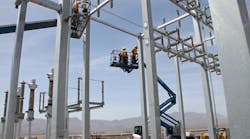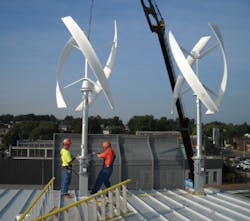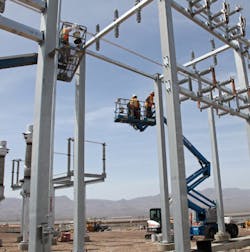For the firms on EC&M’s 2012 Top 50 Electrical Contractors list, being able to take advantage of last year’s turnaround in the construction industry, albeit slow and spotty, largely depended on the market sectors and geographic areas in which they worked. In 2011, private industrial and manufacturing sectors led the limited recovery for the industry. Telecommunications, driven by the need for new data centers, also grew at a steady clip. However, uncertainty about the general U.S. economy and the upcoming presidential election stunted the return of public-sector projects. Markets that rely on government funding, such as transportation, government buildings, and public works (including wastewater and sewer), remained stalled. Yet, incentives and grants for the power segment, including renewable energy sources and storage and the upgrade of the country’s electrical infrastructure to the smart grid, were still made available.
(Photo at right courtesy of Power Design, Inc.)
Driving the average revenue gain, several companies reported significant hikes in their year-over-year numbers and upped their rankings. Minneapolis-based Egan Co. returned to the Top 50 list with a 64.6% jump in revenue. Norwalk, Conn.-based EMCOR Group, Inc. remained in the No. 1 position with growth of 45.6%. Forty-percent growth allowed Minneapolis-based Parsons Electric LLC to jump from No. 22 to No. 16. A 30.7% increase moved Rolling Meadows, Ill.-based MYR Group, Inc. from No. 4 to No. 3.
San Jose, Calif.-based Cupertino Electric, Inc. (CEI) charged from the No. 10 spot to No. 5 by garnering a 69.8% spike in revenue for electrical and datacom services. The firm attributes its astounding increase in revenue and meteoric rise to foresight dating back two years. “In 2011, we executed on the work that we started in 2009,” says John Boncher, president and CEO. “We saw there was a lot of opportunity back then. The bulk of the hard work was done in 2009 and 2010, and in 2011 it was purely just finishing up the plan.”
The long ramp-up time allowed the company to avoid the growing pains of taking on large projects. “We were fortunate because we had a two-year period where we could build up staff and resources to prepare for this,” continues Boncher, who confesses that, as a service provider, the firm may not be able to continue with growth on this scale. “For a service provider, growth numbers like this should make somebody very nervous. It’s not sustainable for anyone in a service industry. This is more a testament to the quality of work we do for our customers and their commitment and loyalty to us because of the quality and the way that we treat them. So we’ll grow as long as we can continue to find customers that appreciate and are willing to pay for what we bring to the table.”
With a 51.3% annual gain, Torrington, Conn.-based Ducci Electrical Contractors, Inc. skyrocketed to the No. 32 position from No. 45. “2011 was naturally a continued difficult economic climate for just about everyone — and it was no different for us,” says Richard J. Ducci, president and CFO. Ducci attributes his firm’s growth last year to continued efforts in performing successfully for its core customers and earning repeat business, as well as expansion of the firm’s geographic and market reach. “We expanded our horizons slightly both in terms of geography as well as the type of work we do — while not straying too far from our basic operating principles,” he concludes.
Fort Lauderdale, Fla.-based Hypower, Inc. moved from the No. 47 position to No. 34 with a 44.6% increase. The firm credits the strength of the power market for its growth in revenue. “Hypower, Inc. benefited in 2011 from government incentives that induced government funded or subsidized projects, such as work on military bases and major solar roll-outs,” says President Bernard Paul-Hus. “This enabled a robust growth rate primarily for Hypower’s Energy Infrastructure Group with moderate to sustained growth for our Power Group, Electrical Group, and Airfield Group.”
(Photo at right courtesy of Guarantee Electrical Co.)
Margin call
Half of the firms on the 2012 Top 50 Electrical Contractors list described the 2011 business climate as “fair,” whereas only eight characterized it as “strong” (Fig. 2). Seventeen contended with a 2011 business climate they thought of as “weak.” In meeting, exceeding, or falling short of revenue expectations for 2011, the firms were mostly divided between exceeding — 20 — and meeting — 22 (Fig. 3). Only eight firms confessed to not meeting revenue expectations for their electrical anddatacom services.
Fewer firms on the 2012 Top 50 Electrical Contractors list expected to exceed revenue projections for electrical and datacom services this year. Eighteen are forecasting that they will exceed revenue expectations, whereas 23 are predicting they will meet revenue expectations, and eight remain pessimistic with regard to revenue expectations (Fig. 4). However, forecasts regarding the timing of a recovery for the construction industry are more varied (Fig. 5). Eight firms predicted the construction economy will improve this year. Yet, 15 reported they don’t expect a recovery until 2013, 21 estimated it won’t happen until 2014, and six pushed recovery back to 2015.
In the meantime, the firms on the Top 50 list reported looking for ways to maximize profits in a climate in which margins are shrinking. Although the traditional project delivery method design-bid-build remains widely used, non-traditional methods, including design-assist and design-build, continue to gain momentum (Table 1). In addition, almost two-thirds of the firms on the list reported using lean construction practices in 2011 (Fig. 6). In addition, just over two-thirds stated they will implement or have implemented lean construction concepts into their work in 2012 (Fig. 7). For instance, according to MYR Group, Inc., it has developed its own process-improvement system.
Despite these competitive conditions, the electrical contractors on the Top 50 list reported the tightening of margins may be easing. When asked about their bids in 2011, 22 firms on the Top 50 list answered that they’d adjusted them for smaller profits or a loss, with 21 reporting no change for profit margin, and only five dialing in greater profits (Fig. 8). However, 15 firms on the list answered that they have adjusted or will adjust bids for greater profits this year. Only five have or will bid at a smaller profit or loss, and 28 are holding or expect to hold the line (Fig. 9).
According to CEI’s Boncher, the construction market in the Bay Area remains competitive, but margins are improving because clients are realizing they get what they pay for. “The market is still as competitive as I’ve ever seen,” says Boncher. However, he says the difference is that at the beginning of the recession, customers were more focused on accepting a low bid cost, sometimes at the expense of quality, and now have refocused on quality. “During the recession, everything was about low cost,”Boncher continues. “But I think they’ve been through a couple of cycles now and have learned that low cost on bid day means absolutely nothing.”
Clients who awarded contracts to low bidders have now returned, dissatisfied with projects delivered over the promised budget and with design deficiencies and quality issues. “Those customers talk to us and say our number was right,” says Boncher, citing an example of a few data center companies that chose CEI because of reputation rather than low bid price. “We hadn’t been able to get through their front door,” he continues. “But now every one of them had the same story: They need to find somebody who can build their data centers for the budget, understand the design, and still help them save money. These opportunities have come more from people dropping the ball for customers and us just sliding in there and doing a great job.”
In the No. 1 position on the Top 50 list, EMCOR Group showed impressive growth in 2011. “Our sustained levels of profitability and liquidity through a difficult economic environment reflect the robustness and resilience of our business model,” said TonyGuzzi, president and CEO of EMCOR Group, in a statement to investors. “We are pleased with our results for the 2011 fourth quarter and full-year periods, which continued to reflect strong execution in a challenging market environment. During the quarter, we delivered solid organic growth, particularly in our facilities services segment, and profitability continued to meaningfully benefit from the successful completion of several large projects and continued strong performance from our companies that perform industrial work.”
Still, Guzzi addresses EMCOR’s current backlog, which contains projects awarded at tighter margins. “While I am very pleased with our results, our execution — and the steps we have taken to enhance our growth prospects for the long term — we continue to operate in the trough of the economic cycle and a sustained upturn remains difficult to predict,” he said in the statement. “Our backlog is solid with an improving mix of attractive commercial and industrial work; however, it is now entirely composed of projects won during these challenging economic times with margins representative of the competitive pressures from the recession. Against this backdrop, our focus will be on strong project execution. EMCOR remains a late-cycle company; however; we are better positioned from a market sector diversity, cost structure, and balance sheet perspective than at any time in our history, and both top and bottom line performance will be enhanced substantially by the eventual up-cycle in our markets.”
Buying Local
(Photo at right courtesy of Cupertino Electric, Inc.)
CEI’s biggest growth was predominantly centered in power generation for the electric utility market, including both traditional and alternative energy sources. The firm also worked on data center projects. With more than five million square feet of data center floor design experience and national recognition for data center construction innovation, CEI’s business has steadily grown in the last year, despite the economic downturn.
Surprisingly, its location in Silicon Valley did not give the firm an advantage for this type of work. According to Boncher, the majority of data center projects are located outside of California. “They’re not in the Bay Area,” he says. “They’re not even in the state.”
As a result, the firm recently announced that it has expanded its data center operations with a new office in Prineville, Ore. “While we have long engineered and constructed data centers in the Pacific Northwest for industry-leading clients, our new office enables us to extend our offerings for current and future data center customers who rely on us to meet their complex electrical needs,” notes Boncher. “Oregon’s business climate, weather, and abundant natural resources make Prineville a great location for our fifth United States-based office.”
In its new location, CEI will hire additional employees. It is not the only firm that added employees in 2011 or has plans to hire this year. Less than half the firms on the Top 50 list reported adding employees in 2011 (Fig. 10). However, 31 are predicting they will add staff in 2012 (Fig. 11). In addition, a dozen firms revealed they opened at least one branch office in the United States last year (Fig. 12), whereas four disclosed they closed at least one branch office in the United States — and four said they acquired a branch office in the United States. Some firms reported both closing and acquiring a branch office in the United States.
To heighten focus on its core strengths, EMCOR implemented a strategy for 2011 that also included the sale of Toronto-based subsidiary Comstock Canada Ltd., to CCL Equities, Inc., for approximately CAD $16.9 million in payment for the shares and approximately CAD $25.5 million in repayment of indebtedness owed by Comstock to EMCOR Group, Inc. In addition, the company acquired Bahnson Holdings and USM Services Holdings. “Over the course of 2011, we undertook a number of actions that further strengthen our business,” said Guzzi. “We increased our focus on our core operations with the sale of our Canadian business, and also took advantage of opportunities to build on our capabilities with the strategic acquisitions of Bahnson Holdings and USM Services Holdings. USM significantly enhances our ability to service multi-site customers and has contributed to push the facilities services segment revenues in 2011 to over $2 billion.”
EMCOR Group’s strategy to divest one company and acquire others that better work toward its existing strengths was a common one in 2011, according to PwC US, which provides industry-focused audit and assurance, consulting, and tax services. Last year, the global industrial products (IP) industry, including engineering and construction, experienced an increase in merger and acquisition (M&A) deal volume over the course of 2011 — 801 deals worth more than $50 million compared to 783 deals in 2010. The majority of these deals within the IP sector were driven by companies focusing on smaller deals, an increase in divestitures, and an uptick in compatible local deals. “2011 was all about smaller deals in industrial products as deal makers remained conservative focusing on deals that were seen as less risky and that needed smaller levels of capital in today’s uncertain economy,” said Bob McCutcheon, U.S. industrial products and metals industry leader at PwC.
According to PwC’s reports, the pace of local deals that were worth more than $50 million increased to 510 deals in 2011 compared to 487 deals in 2010. Industrial products cross-border deals remained flat in 2011 from the prior year — 36.4% of deals worth more than $50 million and 37.8%, respectively. The pace of local market consolidation hastened as IP companies sought compatible enterprises to reduce expenses. “Faced with substantial uncertainty, companies appeared to be opting for growth within their familiar domestic markets,” said McCutcheon. “Such moves limit the legal and cultural risks typically associated with cross-border transactions. We’re also seeing higher growth prospects within emerging markets, which will likely keep Asian acquirers focused on targets within their borders. Mature markets, such as the United States and Europe, also continue to seek domestic consolidation as a tool for growth and competitor elimination.”
A breakout of activity for the engineering and construction industry shows the majority of deal activity in the fourth quarter of 2011 was from small, bolt-on acquisitions, which dropped the average deal value to 2009 low levels of $354 million. With the combination of a sluggish U.S. recovery, reductions in federal and municipal spending, and political gridlock, non-U.S. affiliated deals took the lead in activity during the fourth quarter of 2011.
With regard to this year, the firms on the 2012 Top 50 Electrical Contractors list reported some hesitation regarding acquisition. While 10 firms said they have or will open at least one new branch office in the United States, only two reported they have or will acquire a new branch office in the United States (Fig. 13). This decline in activity is reflected in results for the year so far published by PwC, which reveal M&A activity in 2012 has had a sluggish start. Activity in the engineering and construction industry continued to decline in the second quarter of 2012, primarily due to the continuation of the European sovereign debt crisis, the slowdown in the growth of the Chinese economy, and overall uncertainty of the sector’s growth prospects.
“Engineering and construction deal making remains tied to the overall condition of the global economy due to the highly cyclical nature of the sector,” says H. Kent Goetjen, U.S. engineering and construction leader with PwC.
“The fragile recovery of the industry and its heavy dependence on government spending, which is being curtailed in numerous countries, combined with the cautious global outlook, have all contributed to reduced M&A activity.”
In the second quarter of 2012, there were 34 deals with value greater than $50 million totaling $10.1 billion, compared to 47 transactions worth $14.7 billion in the same period of 2011. While deal value and volume also declined sequentially from the first quarter of 2012, which saw 37 transactions totaling $12 billion, average deal value remained flat during that time period at $300 million. The United States was the most active individual country, with eight deals totaling $2.8 billion. However, the bulk of the U.S. transactions were local and involved targets in the construction machinery segments, partly as a result of the relatively strong growth in U.S. manufacturing.
“We’re seeing more companies looking to strengthen their position through acquisition,” says Goetjen. “Although I would also observe that some of these acquisitions are of companies doing business internationally, there is some international expansion within those local acquisitions.”






